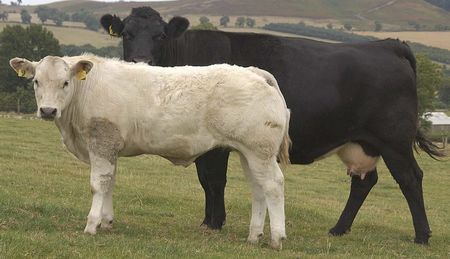Carefully planned diet will keep options open

Sell, store or finish – those are the options facing suckled calf producers this season whose autumn income has been caught up in theslipstream of livestock marketing disruption and escalating feed costs.
But for those who have decided to hold on to weaned calves this winter – despite increases in feed prices – they should be able to keep their options open if they ensure calf diets are carefully planned.
Over-wintering suckled calves can often be a hit-and-miss affair when it comes to feeding and growth rates, but that should not be the case if producers want to be in the best marketing position with these calves next spring, says Keenan nutritionist Donald Brown.
High feed costs could see suckled calves take the brunt of dietary cutbacks in the coming months, but beef advisers believe that would be short-sighted. Producers who take their calves through winter on a diet that makes the most of their forage quality and makes additions to the diet that are effective in terms of cost and performance will have the best marketing options.
“Some producers will already know their plans – either sell their calves in the spring or hang on and finish them. But the problems beef and sheep producers have faced in recent months means more want to keep their options open and reasses the situation in the New Year.
“There’s no reason why decisions have to be made now and producers can confidently sit on the fence for a while, but only if they approach the next four months knowing exactly what calves are eating.
“Fed properly, calves can be taken through to February and then a decision on their future can be made,” says Mr Brown.
He reckons producers with calves that have been on a planned diet until February can be moved up a gear over the following five weeks to get them into a forward condition for sale. If it is decided that calves will be retained and finished after a summer at grass, their winter ration can be maintained until turnout.
“Calves can be switched to the fastlane for a five-week period to get them in a forward condition for sale. But you can’t do it in two weeks and you won’t succeed at all when those calves have been held back during the winter because of shortfalls in the diet,” says Mr Brown.
Although most farms have plenty of forage, which will form most of the feed intake of calves this winter, it is essential to have grass silage analysed to get the best performance from it. Silage qualities are extremely variable, with many hill farming regions hit hard after the wet summer.
Advisers say the aim must be to maximise forage intakes. Adding straw will help prevent too much of the grass-based diet passing straight through the calves, but the key to getting the most from forage lies in achieving the correct balance of protein and energy.
“Silage, if you know precisely what you are dealing with in terms of feed value, should be bought in if necessary because getting as much into these calves as possible is paramount,” says Mr Brown.
For silages which analyse at 10.5MJ of energy and, say, 14% protein, it may only be necessary to give 0.5kg of supplementary feed primarily to improve the digestibility of the diet for calves intended to be sold as stores in the spring.
Potatoes and brewers’ grains should be considered and can be fed at 6-8kg a head (each). Potatoes can replace barley and brewers’ grains can replace maize gluten.
“To get the best from calves this winter, it’s no good sticking a bale of silage of unknown feed value into a ring feeder and expecting it to work. To get the best from suckled calves, it’s essential to encourage feed intakes. And it’s just as important to think about the siting of feeders. A group of calves with insufficient feed space or where feeders are in dirty, muddy conditions will hit intakes and that means lowering growth and undermining calf values in the spring.”

Producers over-wintering suckled calves must get diets and growth rates right to be in the best marketing position.
